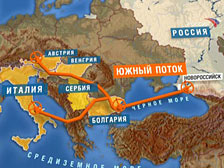“We are not asking for subsidies. But when it comes to access to financing, permitting and regulatory processes ... it would be important to know that the approach by the European authorities is non-discriminatory for the two projects,” Mr Kramer told the Financial Times ahead of Friday’s landmark EU energy summit.
“If you say, well the only reason [for South Stream] is that there are certain people who want to frustrate Nabucco then I would say this is definitely not true. Besides, it would mean that if Nabucco comes to a halt we will also give up – that is not how it works, we are not competing projects.”
The EU’s determination to lessen its dependency on Russian gas, which accounts for about a quarter of EU demand, has spawned a variety of proposals to open up the so-called Southern Corridor in order to tap gas in the Caspian basin and Middle East.
The competition is entering a crucial phase, with Azerbaijan expected to make a supply decision in the coming weeks, which could prove decisive in getting the €7.9bn Nabucco pipeline off the ground.
But the backers of South Stream, which many energy analysts view as a direct challenger to Nabucco, are also pressing ahead with their plan to construct a pipeline under the Black Sea, avoiding Ukraine.
About 80 per cent of Russian gas exports to Europe are currently routed via Ukraine, a situation that proved dangerous in 2009 when a dispute between Moscow and Kiev led to the interruption of supplies to south-east Europe.
South Stream, a joint venture between Russia’s Gazprom and Italy’s Eni, is initiating environmental impact and feasibility studies with a view to making a final investment decision in 2015. Gazprom remains in talks with France’s EDF about it joining the South Stream consortium.
Mr Kramer declined to specify a price tag for the pipeline, which has a capacity of 63bn cubic metres a year, saying only that the total onshore and offshore bill would be within a range of €10bn-€20bn.
South Stream’s chief said fears that Europe would be flooded with gas for which there was currently no demand were misplaced, as the pipeline would only gradually build up from 2015 to its maximum capacity in line with customer demand.
Much of the gas flowing through South Stream would initially be gas that is currently routed through Russia’s existing export pipeline network.
He insisted that economics would determine whether the pipeline was constructed, not political factors as some critics have claimed.
“You couldn’t build a decent business case for South Stream just on the rationale ... of blocking or frustrating Nabucco – that’s totally unrealistic ... It would imply that if Nabucco wasn’t there we would stop South Stream – that’s unthinkable,” he said.
“Russia has many projects to spend its money on and would not spend it on a pipeline system that might not be economical,” he said.
Urging Brussels to recognise South Stream’s potential contribution to greater gas supply route diversity, Mr Kramer said the project deserved to be treated on a par with the other EU-backed projects.
“This is an argument that we have tried to put on the table and the good news is that I see more recognition of that today than was the case a few months ago,” Mr Kramer said.
Russia has already signed a series of political agreements with countries along South Stream’s proposed route, including Bulgaria, Greece, Serbia and Slovenia.
The US ambassador to Italy last month raised the possibility of a merger of South Stream and Nabucco, but Mr Kramer gave the idea short shrift.
“With regard to suggestions as to merging the projects, first of all South Stream is commercially viable in its own right and secondly any decisions on co-operation are for the investors together to take and I see no such initiative,” he said.
"The Financial Times"
23 Декабря 2025 | вторник | 07:40


